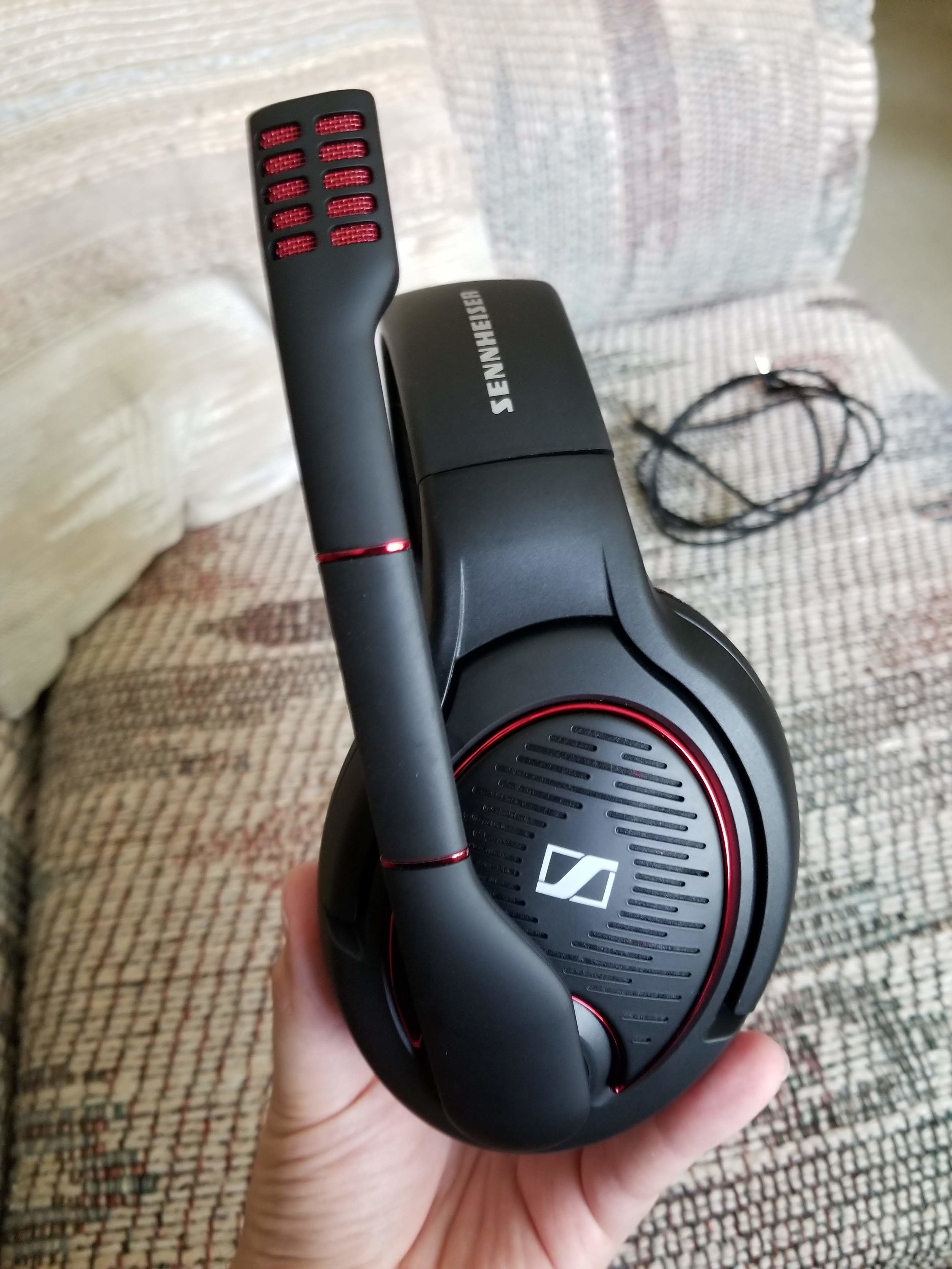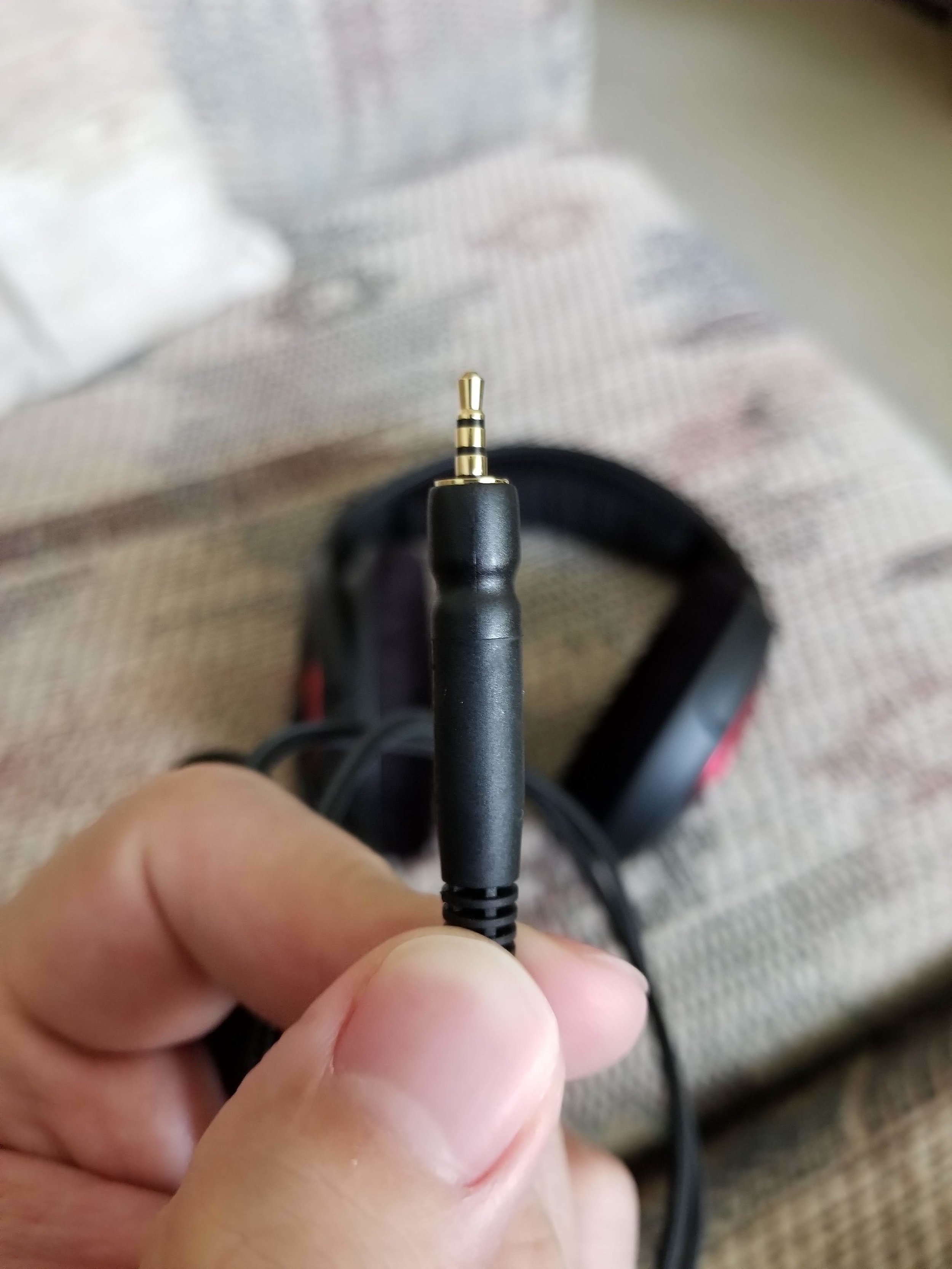Sennheiser Game One Review
The Sennheiser Game One is an HD558 in a different colorway, with a braided and more annoying cable, a broadcast-grade microphone, and exceptional audio performance unless you need all the bass. It's very much worth the price and made me wonder why more gaming headsets aren't open-backed.
Boom! Review over! Please donate to help defray my costs and thank you for reading.
Okay okay, fine.
OVERVIEW
The Sennheiser Game One is an open-backed gaming headset with a permanently attached flip-up-to-mute boom mic, two detachable cables, and an MSRP of $169...though the street price is around $140, depending on the current direction of the wind.
One cable is about 10 feet long and has two 3.5mm plugs, one for the mic and one for audio. The other is a more mobile and console friendly 4 feet long, with a TRRS plug that carries both the microphone and sound signals.
It combines the drivers from Sennheiser's lauded 500 series (tweaked to a console controller-suited 50 ohm impedance and high sensitivity) with an exceptional microphone and little in the way of frills outside of either a black-and-red or white-and-red color scheme.
DIFFERENT VERSIONS
When the Game One first launched, it was called the G4ME ONE, and I think Sennheiser wanted people to say "Game For Me?" I don't even know what the point of that number 4 was.
The original version only came with one cable (the longer 2 plug version), and had higher impedance drivers that didn't work as well with console controllers. It also used to retail for an MSRP of $249.
The PC373D is essentially the same headset, but with a USB cable that enables EQ settings and Surround Sound, and limits your connectivity options. Its MSRP is $249, but I've found it for around $160 online as of this writing.
Massdrop's 37X uses the same underlying design, has a slightly more ho-hum looking grill on the ear cups that shouldn't impact performance, and only comes with the longer cable. But it's just $119, so if you don't need the shorter cable or can deal with getting an adapter, and don't mind the matte black look...it's the most value- conscious version to pick up.
SOUND QUALITY
I'm kind of surprised that more gaming headsets don't use an open back design. Sure, they like to advertise their high isolation for use in eSports environments and for "Better immersion," but how many gamers are truly playing games in loud non-home environments?
I do a lot of writing in coffee shops and often need high-isolation, but when I'm gaming with a headset I'm almost always at home and not blaring other random audio in the room. And an open back headset provides additional benefits like expanded soundstage and no sweat buildup.
The only other high profile headset I can think of that uses an open back is the Astro A40.
Anyway, the Game One sounds wonderful. Like many Sennheiser products, the midrange is just spot-on, with a natural quality that rivals live timbre and pitch quite well. It's the highlight of the audio here...which is a smart/safe tuning decision since that's where most audio actually lives.
Unfortunately, it's not what sounds the most "impressive" to the average listener...that would be the bass and treble. Both of those are present here, but not as hyped as competing products. For me, a weird analytical dude, that's great! But if you're used to the impressive bass and treble performance of other gaming products you'll find these a little underwhelming.
At first.
The bass rolls off gently, and has just enough oomph in the mid-bass to bring a little bit of thump when necessary. The highs are present but not that sparkly, and nowhere near fatiguing.
You might think "That sounds boring, Alex. It sounds like a bland veiled mid-forward Sennheiser product."
First I'd tell you to lay off Sennheiser's typical signature, because it's actually quite pleasant and accurate. And then I'd say "But did you notice the SOUNDSTAGE?"
I think these have the best soundstage of any dedicated "Gaming" headset product. Not surprising, since it's also the highlight feature of the 558/559 that these are so clearly inspired by. If you're a soundstage or imaging junkie, you'll be in heaven here. Even with regular stereo source audio, you'll hear sounds coming from all around you, and a center image that resides far away from the middle of your head.
The accuracy and fun of the imaging make up for any "shortcomings" in the bass, and I'll wager that if you give these a few weeks, you'll adjust to the lowered bass here too...unless you're the most ardent of bassheads.
ISOLATION
There is none! Next!
All kidding aside, all of your audio will leak out, and you'll hear everything in your vicinity unless you really crank these. That's always the trade-off when you open up those cups.
COMFORT
I found these quite clampy for the first day or so I wore them. That's similar to my experience with some other Sennheiser products in the past. However, they loosened up to a point of perfection after a few sessions.
I have no other complaints.
The headband pad is a big squishy piece of velour-covered foam. The ear pads are giant and the drivers are angled inside, so these shouldn't touch your ears at all. The ear pad foam isn't memory foam, but it's quite dense and plush. The sliders have an astounding 19 clicks of adjustment, so they should fit just about any size of head.
I have a larger noggin and I only have to go out to click 12.
If you notice these are too clampy at first, I'd ask you to give them 48 hours before returning them. They're easy to fit properly to your head, and they're light enough to be barely noticeable outside the initial strong clamp.
BUILD/DESIGN
The build here is virtually identical to Sennheiser's 500 series, meaning everything is made out of high-impact plastic. Most companies would go for metal sliders on a product like this, but somehow Sennheiser has gone with plastic and still made them feel solid.
The clicking mechanism has more oomph to it than most metal headbands I've owned in the past, and nothing about the headset feels cheap.
Originally launching in 2014, and being based on a design that's older than that...it's not the most contemporary-looking pair. And the non-detachable mic and open back design mean you won't want to use them outside of your house.
The ear pads snap on and off quite easily, great for cleaning or replacement.
Overall they hug the head nicely without anything awkward sticking out save the mic, they feel solid in the hands, and they come with a 2 year warranty.
EXTRAS
Let's talk about the one thing I find truly frustrating with this headset: the cables. The lengths are fine. The deeply-recessed 2.5mm plug on the headset side stays in securely, even if it's annoyingly proprietary. The braiding is nice and helps reduce noise that's transferred through shirt contact.
But oh man, do these things love to bend, stay stiff, and retain kinks.
These are some of the most comically resistant-to-straight-lines cables I've ever used. The short cable is less frustrating solely by virtue of being shorter. Here's what my long cable looked like even after a week of use and constant attempts to straighten it out. This is its natural resting position.
They don't feel cheap, and it's not a deal breaker...but they really love to kink and bend and feel stiff. It's bizarre. I've seen great, pliable braided cables out of Razer, HyperX, and Logitech in cheaper products. And I've never had an issue with a Sennheiser cable in the past. But these are too stiff for my tastes.
Maybe they'll loosen up in the future.
The right ear cup has a very smooth volume wheel with no channel imbalances. I wish the cables were as smooth as the volume wheel.
MICROPHONE
Sennheiser makes the best microphones in the gaming space, period. You can buy this, the Game Zero, or any of the GSP headsets and immediately know you're getting a broadcast-quality microphone with good background noise cancellation. It's well beyond the quality needed for game voice chat, and exceptional in pretty much every possible way.
This is the standard for microphones in gaming products, and it'd be hard to make this better short of finally making it removable.
Here's a test I recorded!
WHO SHOULD BUY THIS?
If you're looking to play a lot of games in a home environment, and/or record your own voice for a podcast or a stream, then this should be near the top of your list. It has a soundstage that's pretty much unrivaled without the use of virtualization software, and a natural, pleasant tone to its audio.
If you're a basshead, consider a closed-back pair instead. If you're going to do listening in loud environments or near other people, once again, consider closed-back headsets!
You won't need any special amplification. The lower impedance and high sensitivity of this new pair means it sounds good even out of the stupid PS4 controller...unless you need the loudest possible volume. I tested it!
COMPARISONS
Normally I'd sound off here about similarly-priced products. But since it's open, and slightly more expensive than other things...it's going to be more about whether you can deal with those open cups.
At ~$140, this is priced higher than most other gaming headsets.
The only non-Sennheiser pairs with a comparable level of microphone quality are the G433, the Arctis lineup, the G Pro, and the Astro A10. So if microphone is a priority, start here!
Most of its differences when compared to other products on the market come down to whether you want an open backed pair or not. Can you give up bass performance in exchange for soundstage? Are you okay with having no isolation? Those are the big questions to ask yourself here. If you can say a resounding YES to both of those, then the Game One should be your main contender. Sennheiser also offers an open-backed GSP 500 which I haven't tried (Yet!) but at $229, it's hard to see what it could possibly offer over this classic design to be worth that price increase.
That's a veiled way of saying I think the Game One looks less stupid than the higher-priced GSP 500. But that's just me. :)
FINAL THOUGHTS
I've put off buying these for a long time, even though half of my favorite YouTubers and streamers have raved about them since their launch in 2014, for their combination of natural, wide sound performance and an exceptional microphone.
I'm surprised that more companies haven't learned the big lessons of this pair four years on, and surprised that Sennheiser moved away from this classic design in their bulky GSP series.
Lots of folks in the audiophile community like to shun the very concept of gaming headsets, and think you should buy nice headphones and a dedicated mic instead. With the Game One, you're doing exactly that in a very solidly-priced package. Maybe they're not "exciting" enough to appeal to the gaming market at large, and that explains Sennheiser's newer bolder-looking products...but boy, there's a reason these have stayed on the market for so long.











